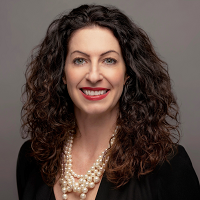Annual Conference: New HFMA CEO Ann Jordan describes her vision for the Association
In her first formal remarks since taking the helm this month, Jordan said she’ll look to focus on member value and mission impact.
Speaking Sunday at Annual Conference, Ann Jordan articulated her vision for how HFMA can support members and positively affect the healthcare industry.
Jordan, who succeeded Joe Fifer as president and CEO on June 6, described growing up on a farm in Iowa (“my first career endeavor at the age of 9 was field labor”), then moving on to a career as a practicing attorney and to executive leadership roles in corporate development and enterprise risk management.

Switching gears, she sought out a role that would allow her to be mission-driven — “to apply my energy, my competencies, to advance a calling and cause above profits and shareholders, and to hopefully make the world a little bit better.” She also wanted to engage in servant leadership, “to serve and support my teams and the organization first [and] to foster an inclusive environment where all voices are heard, relationships and communities need to be strong, and empathy is expected.”
She found a job that met those criteria at ASQ, ultimately becoming CEO of the global association for advancing quality and organizational excellence, with more than 200 chapters. Healthcare is among the association’s 27 technical communities.
When HFMA came calling, Jordan could not pass up the opportunity.
Helping members be all they can be
For Jordan, member value was a central focus during her time with ASQ and will continue to be with HFMA.
“The most rewarding part of being in leadership in the professional association space is that you find yourself in the position to see the potential in others — whether that be individuals or communities — that they might not yet see in themselves,” she said.
Saying she’s “honored” to take over for Fifer, who retired after 11 years as CEO, Jordan acknowledged she has “big shoes to fill” and pledged to build on the Association’s achievements of the last decade. Those include surpassing the 100,000-member mark in April.
“I think it’s safe to say that both Joe and the HFMA Board of Directors agree we must do more,” Jordan said. “We must set new goals to meet both current and future needs in the profession.
“And this means expanding beyond our foundation of education, certification and content to delivering real solutions … shifting from reactive offerings to proactive problem-solving.”
At a time when disruptors increasingly are making an impact in healthcare, Jordan suggested HFMA should lead the industry in adopting similar tactics.
That could entail expanding on the profile of the traditional HFMA member, she said, “to modernize the finance of health and healthcare.”
HFMA must continue to serve both individual and enterprise members, Jordan said. “We will better facilitate and govern that duality in a way that is mutually beneficial and sustainable. That involves value strategies focused on data, benchmarking, new revenue streams, consumerism, risk management, and of course innovation.”
She knows a longtime strength of HFMA is the sense of community it fosters, including at the chapter level. Jordan said she’s excited to travel to chapters starting in the fall.
A solution-oriented mindset
Jordan also hopes to ramp up HFMA’s industry-level focus on the cost effectiveness of health.
“I do not need to tell the people in this room and participating virtually that these are dynamic and challenging times for the healthcare industry,” she said. “Some go beyond calling it a crisis and go so far as to predict the eventual financial collapse of the U.S. healthcare system altogether.”
But solutions are within reach, she said, and they can and should be driven by HFMA members. “Who better to lead than you? And if not you, the subject-matter experts, then who?”
She concluded, “Let’s be inspired and hold ourselves accountable to become more than what we are today. You have my word that I will fully embrace the privilege to advance member value and mission impact for the membership of HFMA.”





